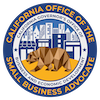Does your small business develop innovative technology that might help federal government agencies achieve their goals? Then you should know about The Small Business Innovation Research (SBIR) Program and the Small Business Technology Transfer (STTR) Program. I talked to SBDC Business Advisor Rogelio Nochebuena who has helped several small businesses obtain SBIR and STTR awards, shares his advice on how businesses can benefit from these programs.
 Can you briefly explain the SBIR/STTR programs and how they help small businesses?
Can you briefly explain the SBIR/STTR programs and how they help small businesses?
“The main objective is to improve the competitive standing of [small businesses] in developing technology to keep the U.S. a hub of innovation,” says Nochebuena. In Phase 1, qualifying small businesses receive funding of up to $100,000 to explore the feasibility of an idea or technology for 6 months. In Phase II, qualifying small businesses that have completed Phase 1 receive up to $750,000 in funding to conduct R&D and evaluate the idea’s commercial potential. In Phase 3, the product moves into the marketplace, and the business must find private sector or other non-SBIR/STTR federal agency funding. The two programs are very similar except that the STTR program includes both for-profit and nonprofit organizations, while the SBIR program focuses on for-profit businesses.
What types of businesses typically qualify?
Eleven federal departments participate in the SBIR program; five participate in the STTR program. “Due to the diversity of agencies participating, the technologies span from agriculture to space exploration,” says Nochebuena. The definition of “small businesses” is based on SBA size standards.
What is the first step in applying for SBIR/STTR awards?
“Identify a market need you could satisfy using a technology that your organization either has developed or could develop with the necessary funds,” says Nochebuena. “Then look at the solicitations the government agencies present on their websites.”
What are the major criteria for getting a Phase I award in either program?
“You need a great business plan identifying a market need that a given technology can solve,” says Nochebuena. “The objective is not to showcase your technology, but to highlight how your technology becomes the ‘key enabler’ to solve a market need that represents potentially a lot of money.”
Nochebuena says your business plan should demonstrate that you have a great team; understand the market problem and have identified a solution; are aware of the competition and have a better, faster or cheaper solution; have obtained or are in the process of getting the proper IP protection or could license the technology from a university, government agency, private company or individual; and can, at the end of Phase I, use calculations, simulations or other means to show that your technology would work to solve the market problem.
How can entrepreneurs improve their chances of getting SBIR/STTR awards?
“Identify the agency that best aligns with your area of expertise so you can speak their lingo,” says Nochebuena. “Then demonstrate that you have a team capable of overcoming the challenges you will face. For many agencies, you need a Principal Investigator with enough academic and business credentials to give the reviewers a warm feeling that he or she can make things happen.”
Nochebuena recommends filing your business plan at least a week before the deadline. “The reviewers, who are in most cases very accomplished business and technical people, can often provide insights to help make your plan more effective,” he explains. He also suggests filing applications with more than one agency. “Often, their solicitations are seeking similar solutions,” he says.
What are some common mistakes entrepreneurs make when applying for SBIR/STTR awards?
“You must produce a credible market analysis,” warns Nochebuena. If you can’t do so, he recommends contacting local business schools’ faculty to see if their students will take on your market analysis as a school project. “Never state in your business plan, ‘There is no competition,’ ” he says. “If you do, your plan will be tossed in the garbage.”
What should entrepreneurs know about the different phases of SBIR/STTR awards?
“At the conclusion of [Phase 2] the entrepreneur needs to find a commercial partner or investor to commercialize the technology,” Nochebuena explains. “It’s sad to see that many companies develop great technology to solve a problem, but are not able to commercialize it because they never establish a strong relationship with a larger organization or investor to move the technology to market.”
What’s important to know about the SBIR/STTR award process?
“Federal agencies, just like VCs and angel investors, want to mitigate what they perceive as the greatest risk—execution,” says Nochebuena. “They need to feel that the team will overcome the challenges they face and will do anything to deliver on time and under or on budget. Having a business plan that addresses such issues is vital.”
Learn more about the SBIR/STTR programs at the SBA’s website: www.sba.gov
Rieva Lesonsky is founder and President of GrowBiz Media, a media and custom content company focusing on small business and entrepreneurship. Before launching her business, she was Editorial Director of Entrepreneur Magazine. Follow Rieva at Twitter.com/Rieva and visit her website SmallBizDaily.com to get the scoop on business trends and sign up for free TrendCast reports.





